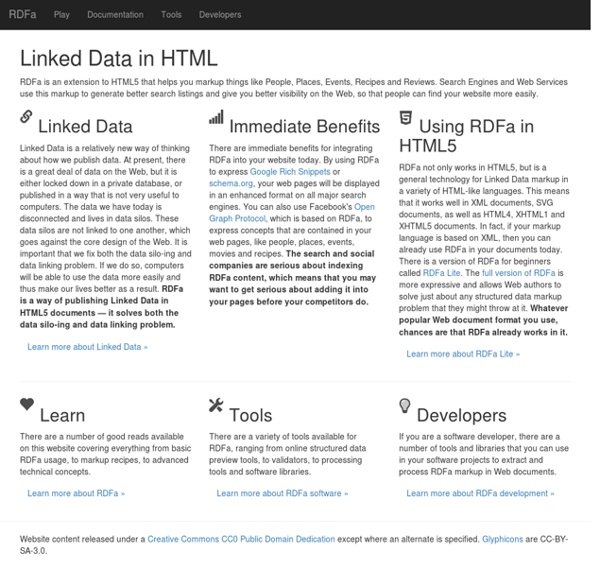



Main Page-fr · Microformats Wiki Les microformats sont des extensions au HTML pour marquer les personnes et organisations, événements, endroits, billets de blog, produits, critiques, C.V., recettes etc. nouveau ! Introduction Ce wiki est la ressource centrale de la communauté microformats et fournit des guides de publication des microformats, des références, des spécifications, des drafts, des modèles de publication, de la recherche, du brainstorming et de la résolution de problème. Pour démarrer Pour démarrer avec les microformats : Premièrement, familiarisez-vous à écrire vos pages et applications avec du HTML 'CHIC'. Définition Les microformats sont des petits modèles de HTML pour représenter des choses communément publiées comme des personnes, des événements et des mots-clé dans les pages web. Les microformats sont le moyen le plus rapide et le plus simple pour fournir une API vers la data et l'information dans votre site web. Comment contribuer ? Vous voulez nous rejoindre et contribuer ? Spécifications nouveau ! Drafts
Home Dublin Core Un article de Wikipédia, l'encyclopédie libre. Le Dublin Core est un schéma de métadonnées générique qui permet de décrire des ressources numériques ou physiques et d’établir des relations avec d'autres ressources. Il comprend officiellement 15 éléments de description formels (titre, créateur, éditeur), thématiques (sujet, description, langue…) et relatifs à la propriété intellectuelle. Le Dublin Core fait l'objet de la norme internationale ISO 15836, disponible en anglais et en français depuis 2003. Il est employé par l'Organisation mondiale de la santé, ainsi que d'autres organisations intergouvernementales. Le Dublin Core a un statut officiel au sein du W3C et de la norme ISO 23950. Historique[modifier | modifier le code] Le groupe de travail de mars 1995 a été commandité par l'Online Computer Library Center (OCLC) et le National Center for Supercomputing Applications (NCSA). Y participaient : Organisation[modifier | modifier le code] Description[modifier | modifier le code] Archives ouvertes
JSON-LD - JSON for Linking Data XFN - XHTML Friends Network XFN™ (XHTML Friends Network) is a simple way to represent human relationships using hyperlinks. In recent years, blogs and blogrolls have become the fastest growing area of the Web. <a href=" rel="friend met">... To find out how to write and use XFN, or to write a program to generate or spider it, read the following sections: Introduction and Examples Introduction to XFN, examples, styling suggestions, and future potential. Getting Started Join the XHTML Friends Network in just four easy steps! Profile Version 1.1 of the XFN meta data profile: the list of the values used in XFN with their significance. Background The thinking that went into the design of XFN, why particular values were chosen, and why other values were left out. Frequently asked questions about XFN. XFN Tools A collection of tools, templates, editors, communities, and other resources that let you edit XFN information. XFN and ... How to use XFN with numerous social network services and other technologies. Press
Semantic Web Standards Tails Export Welcome to the microformats wiki! Folksonomie Un article de Wikipédia, l'encyclopédie libre. Une folksonomie, ou indexation personnelle, est un système de classification collaborative décentralisée spontanée, basé sur une indexation effectuée par des non-spécialistes.Techniques permettant à l'utilisateur d'un outil (internet ou autre) de donner son avis sur une ou plusieurs pages web. Synonymes[modifier | modifier le code] L'expression francisée recommandée par la Commission générale de terminologie et de néologie est indexation personnelle[1]. Description[modifier | modifier le code] L'intérêt des folksonomies est lié à l'effet communautaire : pour une ressource donnée sa classification est l'union des classifications de cette ressource par les différents contributeurs. Le concept de folksonomie est considéré comme faisant partie intégrante du Web 2.0. Par exemple, le site Flickr permet le stockage massif des photos, accessibles par défaut à tout le monde. Caractéristiques de la folksonomie[modifier | modifier le code]
MDN Web Docs Microformats Standards OASIS Cyber Threat Intelligence (CTI) TC Cite as: [STIX-v1.2.1-Overview]STIX(TM) Version 1.2.1. [STIX-v1.2.1-Common]STIX(TM) Version 1.2.1. [STIX-v1.2.1-Core]STIX(TM) Version 1.2.1. [STIX-v1.2.1-Indicator]STIX(TM) Version 1.2.1. [STIX-v1.2.1-TTP]STIX(TM) Version 1.2.1. [STIX-v1.2.1-Incident]STIX(TM) Version 1.2.1. [STIX-v1.2.1-Threat-actor]STIX(TM) Version 1.2.1. [STIX-v1.2.1-Campaign]STIX(TM) Version 1.2.1. [STIX-v1.2.1-COA]STIX(TM) Version 1.2.1. [STIX-v1.2.1-Exploit-Target]STIX(TM) Version 1.2.1. [STIX-v1.2.1-Report]STIX(TM) Version 1.2.1. [STIX-v1.2.1-Extensions]STIX(TM) Version 1.2.1. [STIX-v1.2.1-Data-Marking]STIX(TM) Version 1.2.1. [STIX-v1.2.1-Vocabularies]STIX(TM) Version 1.2.1. [STIX-v1.2.1-UML-Model]STIX(TM) Version 1.2.1.
new pearl The Semantic Web is a web of data. There is lots of data we all use every day, and it is not part of the web. I can see my bank statements on the web, and my photographs, and I can see my appointments in a calendar. Why not? The Semantic Web is about two things. See also the activity news for an account of recent events, publications, etc. The following groups are part of the Semantic Web Activity. Active Groups Semantic Web Coordination Group The Semantic Web Coordination Group is tasked to provide a forum for managing the interrelationships and interdependencies among groups focusing on standards and technologies that relate to this goals of the Semantic Web Activity. RDFa Working Group The mission of the RDFa Working Group, formerly known as the W3C RDF Web Application Working Group, is to support the developing use of RDFa for embedding structured data in Web documents in general. RDF Working Group Linked Data Platform Working Group Semantic Web Interest Group Past Groups OWL Working Group
Home